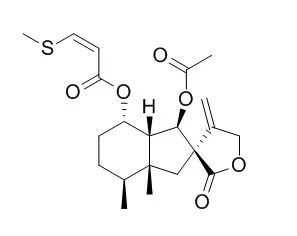| Description: |
Bakkenolide D has anti-allergic effect, it and bakkenolide D demonstrates inhibitory effect on the trachea contraction induced by histamine in vitro, they have obvious anti-histamine activities. |
| Targets: |
IL Receptor | Histamine Receptor |
| In vitro: |
| Academic Journal of Second Military Medical University, 2006, 27(11):1210-1213. | | Chemical constituents in root of Petasites tricholobus Franch. and their anti-inflammatory activity[Reference: WebLink] | To study the chemical constituents in the root of Petasites tricholobus Franch, and evaluate their anti-inflammatory activity.
METHODS AND RESULTS:
The primary extraction was done with 95% ethanol and subsequently with other agents including ethyl acetate. The compounds extracted with ethyl acetate were isolated by silica gel column chromatography and purified by means of recrystallization. The structures of the compounds were elucidated by employing chemical and spectral methods. The anti-inflammatory activities of the compounds were evaluated through their inhibitory effect on the trachea contraction of guinea pig induced by histamine in vitro. Six compounds were isolated from the root of Petasites tricholobus Franch., namely, homofukinolide(1), bakkenolide B(2), stigmasterol(3), and β-sitosterol(4), Bakkenolide D(5), and β-sitosterol-3-O-β-D-glucopyranoside(6). Bakkenolide B and Bakkenolide D demonstrated inhibitory effect on the trachea contraction induced by histamine in vitro.
CONCLUSIONS:
Homofukinolide, β-sitosterol, and β-sitosterol-3-O-β-D-glucopyranoside are isolated for the first time from Petasites tricholobus Franch. Bakkenolide B and Bakkenolide D have obvious anti-histamine activities. |
|
| In vivo: |
| Phytother Res. 2011 Jan;25(1):116-21. doi: 10.1002/ptr.3237. | | Anti-allergic effects of total bakkenolides from Petasites tricholobus in ovalbumin-sensitized rats.[Pubmed: 20625987] | The anti-allergic effect of total bakkenolides from the rhizome of Petasites tricholobus (BAPT) was evaluated in an ovalbumin-induced allergic rhinitis model in male Wistar rats.
METHODS AND RESULTS:
The major components of the bakkenolide fraction are Bakkenolide D, bakkenolide B, bakkenolide IIIa and bakkenolide IVa, which account for 60.04% of the total. The rats were treated with 40 mg/kg, 20 mg/kg, 10 mg/kg or 5 mg/kg BAPT, and 0.942 mg/kg loratadine and 0.5% gum tragacanth were used as positive and negative controls, respectively. The frequency of nose rubbing and sneezing was observed, the number of eosinophils infiltrating into the nasal tissue was counted, and serum levels of IL-4 and histamine were determined by ELISA.
CONCLUSIONS:
The results showed that BAPT had a beneficial effect on allergic rhinitis in ovalbumin-sensitized Wistar rats, which was evidenced by a significant decrease in the frequency of sneezing, the number of eosinophils infiltrating into the nasal tissue, and the serum levels of IL-4 and histamine. BAPT may therefore be a potential antiallergic drug. |
|






 Cell. 2018 Jan 11;172(1-2):249-261.e12. doi: 10.1016/j.cell.2017.12.019.IF=36.216(2019)
Cell. 2018 Jan 11;172(1-2):249-261.e12. doi: 10.1016/j.cell.2017.12.019.IF=36.216(2019) Cell Metab. 2020 Mar 3;31(3):534-548.e5. doi: 10.1016/j.cmet.2020.01.002.IF=22.415(2019)
Cell Metab. 2020 Mar 3;31(3):534-548.e5. doi: 10.1016/j.cmet.2020.01.002.IF=22.415(2019) Mol Cell. 2017 Nov 16;68(4):673-685.e6. doi: 10.1016/j.molcel.2017.10.022.IF=14.548(2019)
Mol Cell. 2017 Nov 16;68(4):673-685.e6. doi: 10.1016/j.molcel.2017.10.022.IF=14.548(2019)